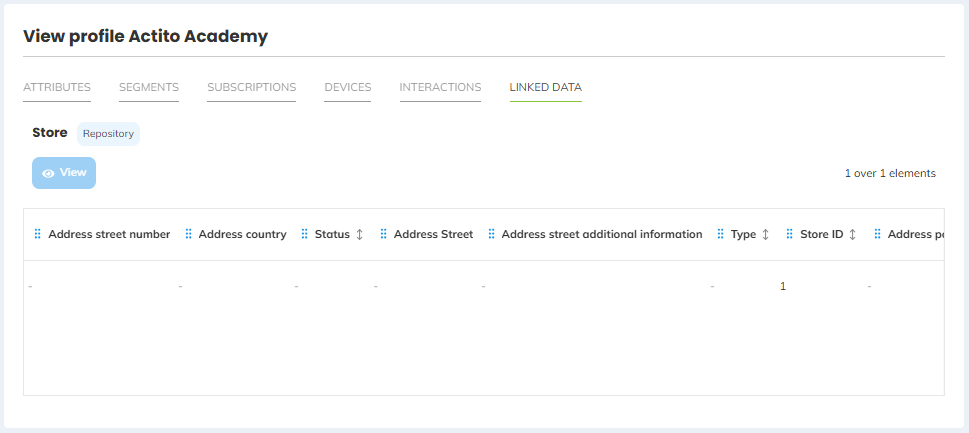Reaching a profile file
To see the detailed file of a profile, go to the 'Profiles' app (Apps > Profiles > Profiles).
You can reach this app directly with the 'quick menu', under the Profiles tab.
Choosing the table
Select the profile table in which you want to look up a profile, then click on the 'View profiles' button.

If you have only one profile table, you will not need to choose a table and you will go directly to the next step.
Searching for a profile
After selecting your table, the 20 last added profiles are displayed by default, with columns corresponding to the different attributes of your database.
A selection of relevant attributes is displayed by default. You can modify those by clicking on the icon situated on the top right of the screen.
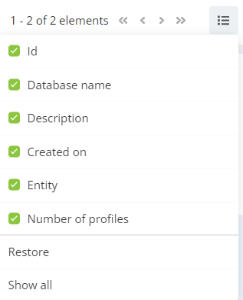
You will be able to search one or more particular profiles. To do so, you can:
- do a quick search via the 'find a profile' tab
- do a targeting via the 'explore profiles' tab
Find a profile
In the "Find a profile" tab, you will be able to search among the total of profiles in your database (displayed on the right of the text box).
You will be able make a research based on the following criteria:
- the standard attribute "E-mail address" (emailAddress)
- the combination of the standard attributes "First name" (firstName) & "Last name" (lastName)
- the standard attribute "Mobile phone" (gsmNumber)
- the technical attribute "Profile id" (profile Id) which corresponds to the id generated by Actito.
- any other attribute defined as unique key in your database, for instance: a client identification number (client id)

The E-mail address, Mobile phone, First name and Last name attributes are available by default, even though they aren't unique or mandatory in your database. However, those fields must be based on predefined attributes.
Fundamentals of the search
- If the field is of type "integer" (for instance: a client identification number, the technical profileId), the search will be done based on an exact match.
- If the field is of type "text" (e-mail address, first name and last name...) the search will first attempt to find an exact match. If no result is found, the search will automatically continue based on an approximative match and show profiles containing the entered characters.
- When doing an approximative search, a maximum of 20 profiles will be displayed. If the result exceeds this number, you will be informed at the top right with an invitation to use the "Explore" function. Click on the button to automatically launch a targeting based on the search criteria.
Explore profiles
The "Explore profiles" function allows you to use the targeting app in order to do a broad selection based on a selection of criteria.
By default, the 20 last added profiles are displayed.
To select profiles based on a targeting, click the "Define" button.
The targeting app will open in a sidebar, allowing you to combine different modules corresponding to the interactions saved by Actito.
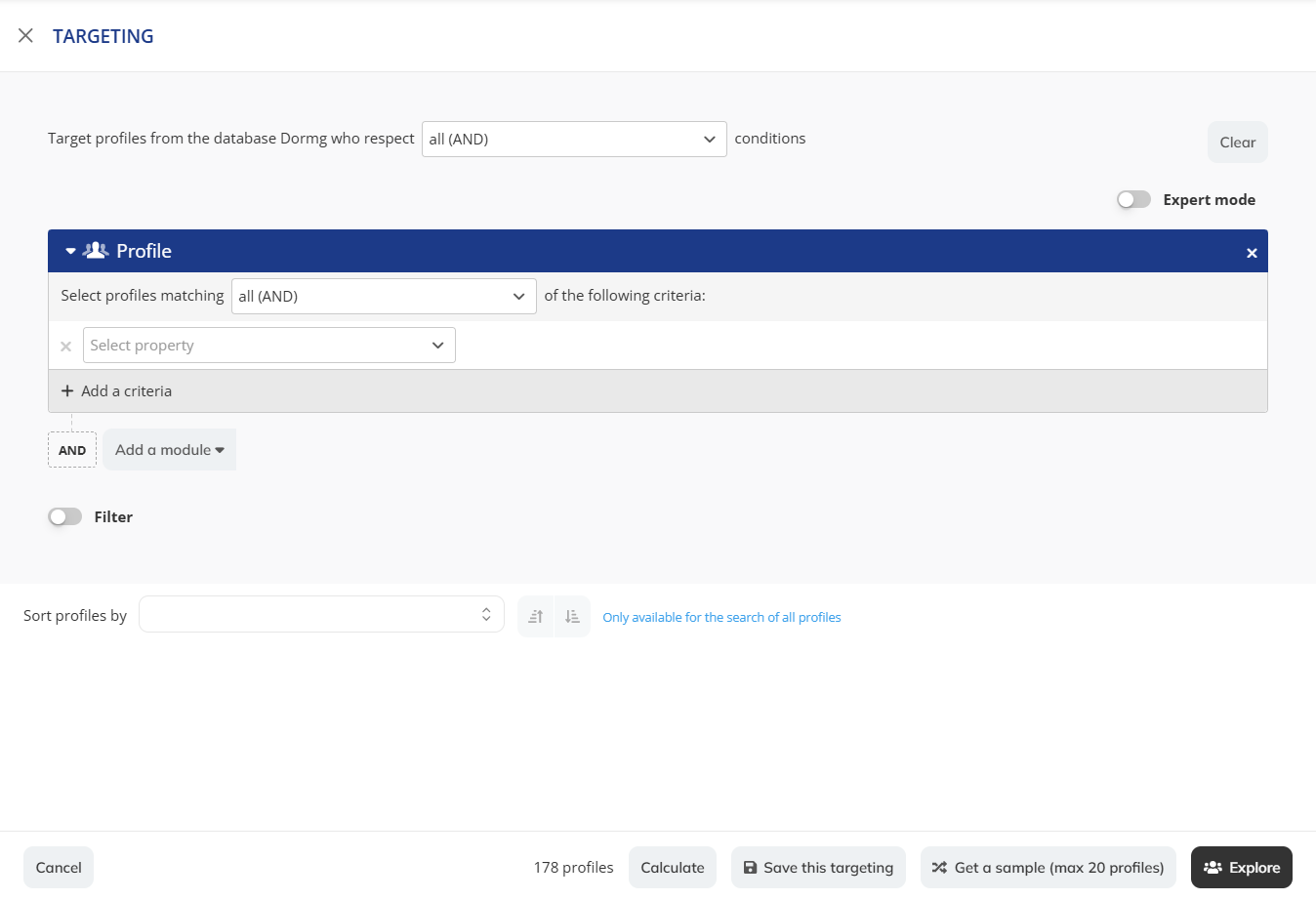
For more information on this app, please refer to the chapter "Targeting".
If you want to know how many profiles match your targeting criteria, click on the ‘Calculate’ button.
This will display you the number of profiles targeted. You can click on this button each time you make a change, to see the number of profiles targeted in real time.
No need to wait for the entire result of you database! If you want to be quick, you can get a sample of maximum 20 profiles by clicking on the button on the bottom right side of the page.
Saving your targeting
Before launching the exploration of the profiles, you can save the definition of the targeting thanks to the button "Save this targeting", at the bottom right of the tab.
A popup window will open, allowing you to define a name and a description for your targeting.
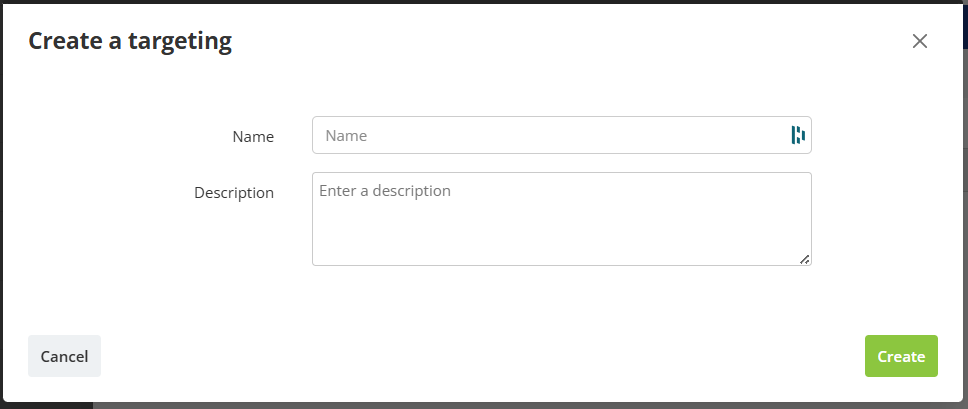
This allows you to create a "saved targeting", as if you had defined the criteria in the dedicated app.
Navigate through the search
Once the result of the targeting is calculated, all the corresponding profiles are displayed in pages of 20. You have the possibility to navigate through these pages.
By default, the profiles will be sorted according to their date of creation, but, when defining your targeting, you have the possibility to choose the display criteria as well as the ascending or descending order.
You can "Edit" your targeting to modify the selection criteria or the display order of the profiles.
Keeping the targeting
Once the targeting is calculated, its definition will be kept in memory for the user who launched the calculation.
Thus, the next time the same user will access "Explore profiles", the targeting and its result will appear again (even after logging out).
The result of a targeting can vary in time according to the selection criteria. This is why the time and date of the calculation is displayed at the top of the screen.
To refresh the targeting, click the "Refresh" icon.
You can also clear the targeting in memory.
Export your selection
To export your targeting's result, click on the button "More" and then "Export explored profile(s)".

You will be redirected to the "Export profiles" module.
Display a profile file
Once the profile has been found through a search or targeting, you can view the detailed profile file.
To do this, select the line of this profile. The line turns green. Then click on "View".
You can also double-click on the selected profile line.

The tabs of a profile file
In the profile file, you will find the different types of components of your profile table. Each of their own uses are detailed in the 'Understanding the components of a profile table' chapter.
This information is organized in tabs.
Attributes
This tab shows:
- basic data about the profile (socio-demographic data, interests...)
- other attributes linked to the profile (age...)
- technical attributes linked to the profile (creation time...).
- the engagement score of the profile
Attributes
In this first category, you'll see the attributes you added to your profile table. These attributes can be predefined or custom.
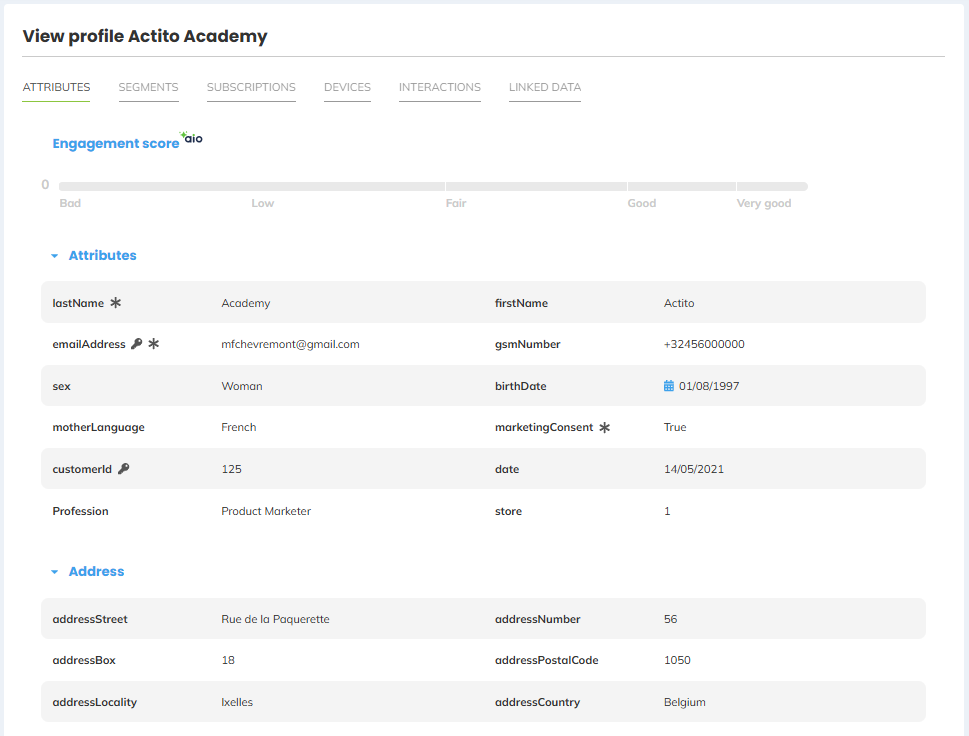
Other attributes
In the 'Other attributes' category, you'll find the following attributes:
- Profile age: the age of the profile is computed automatically if the predefined attribute birthDate was used
- E-mail domain group: based on the list you can find in the article 'Targeting by sending domain'
Technical attributes
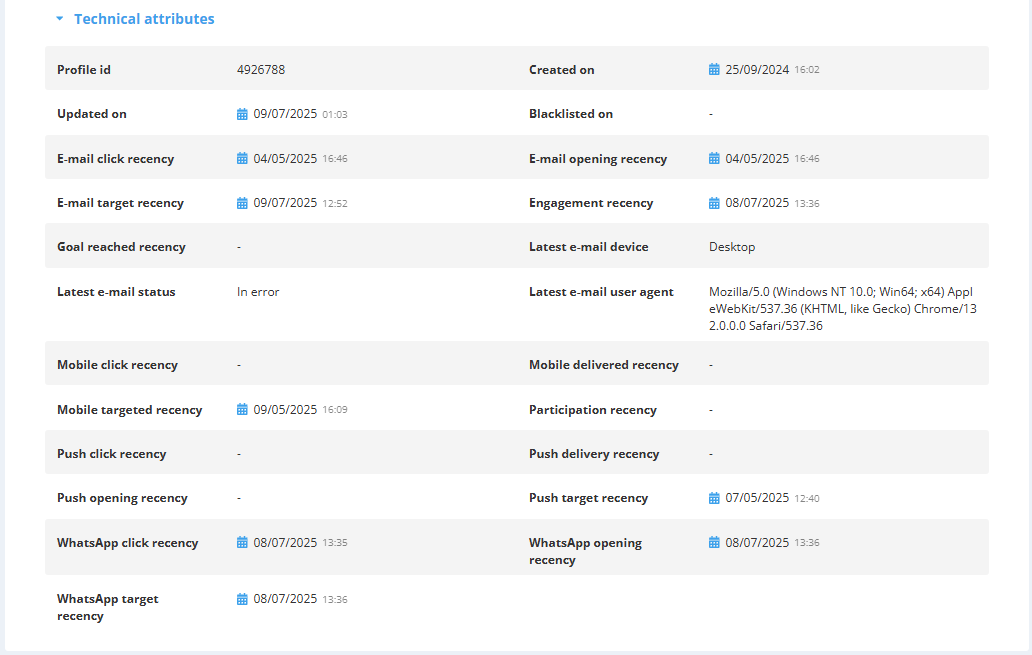
There are also a number of technical attributes collected by default by Actito:
- Profile id: the ID automatically provided to a profile after its creation
- Created on: the moment of the creation of the profile
- Updated on: the moment of the last modification of this profile
- Actito Engagement recency
- Blacklisted on: the moment when the profile was blacklisted
- E-mail click recency: the last moment when this profile clicked on an e-mail
- E-mail opening recency: the last moment when this profile opened an e-mail
- E-mail target recency: the last moment when the profile was targeted
- Goal reached recency: the last moment when the profile has last reached a goal (website visit goal or transaction goal)
- Latest e-mail device: the last type of device used to read the last e-mail
- Latest e-mail status: the profiles' status from last time they were contacted and if it is quarantined or blacklisted
Possible status: Auto reply, Hard bounce, Soft bounce, Clicked, Blacklisted by user, Catch all domain, Commercial pressure, Email address already contacted, Invalid email address, Long-term quarantine, Low quality email address, No email address, Other, Temporary quarantine, Too low activity, In error, Opened, Sent - Latest e-mail user agent: the version and configuration of the device used to read the last e-mail
- Mobile click recency: the last moment when the profile has last clicked in an SMS message with a short URL Actito
- Mobile delivered recency: the last moment when the profile has last received an SMS message
- Mobile targeted recency: the last moment when the profile has last been targeted by an SMS campaign
- Participation recency: the last moment when the profile has last filled in a form (partial or complete participation)
- Push click recency: the last moment when the profile has last clicked in a push notification
- Push opening recency: the last moment when the profile has last opened in a push notification
- Push delivery recency: the last moment when the profile has last received a push notification
- Push target recency: the last moment when the profile has last been targeted by a push campaign
- WhatsApp click recency: the last moment when the profile has last clicked a WhatsApp campaign
- WhatsApp opening recency: the last moment when the profile has last opened a WhatsApp campaign
- WhatsApp target recency: the last moment when the profile has last been targeted by a WhatsApp campaign
Modifying a profile file layout
If the order in which the attributes are showed in your profile files doesn't really match your needs, you can modify it and create sub-sections via the 'Profile tables structure' app (Apps > Data > Profile tables structure).
Find the relevant profile table, double click it or select it and, then, click on "Update". Now, click on "More" and "Edit Layout".
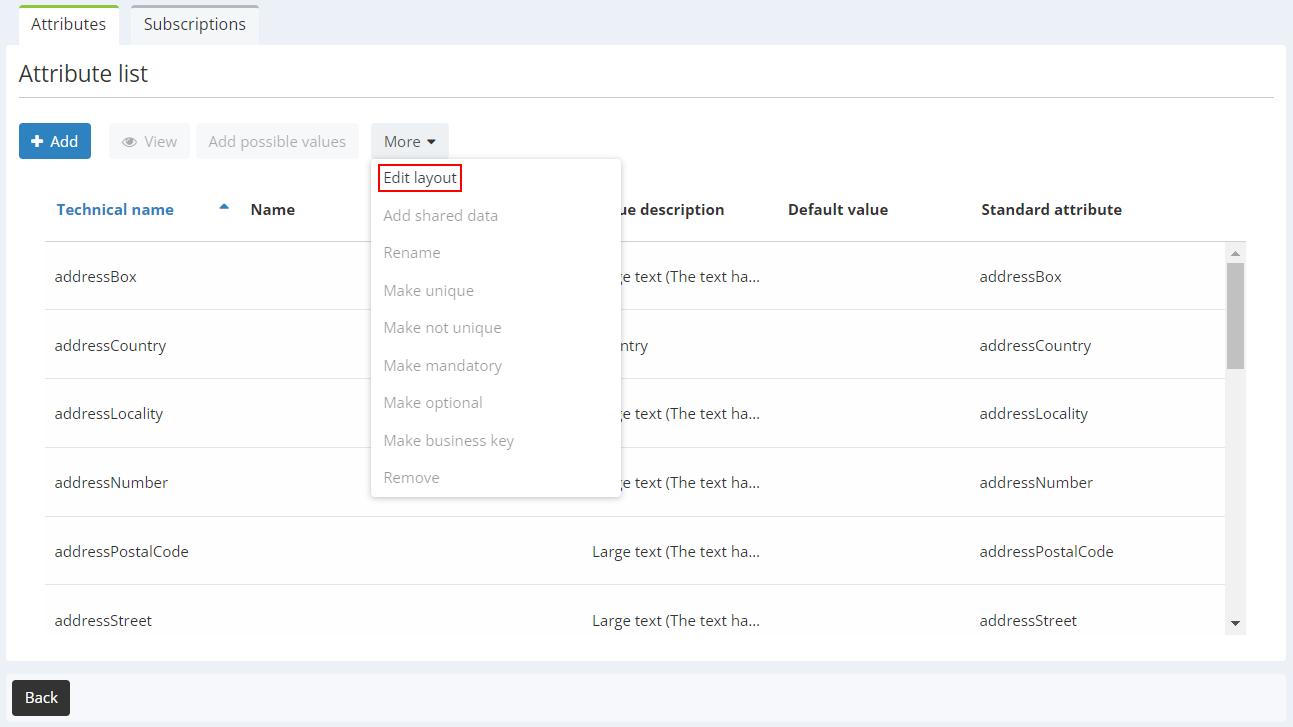
From this interface, you can modify the attributes' layout and order by just dragging and dropping them in their new position.

You can also create sections to group attributes containing similar information, which may make easier reading long and very complete profile files. For that, you just need to click on "+", fill in the section's name and click on "Add". To add attributes to the new section, drag and drop them on the section.
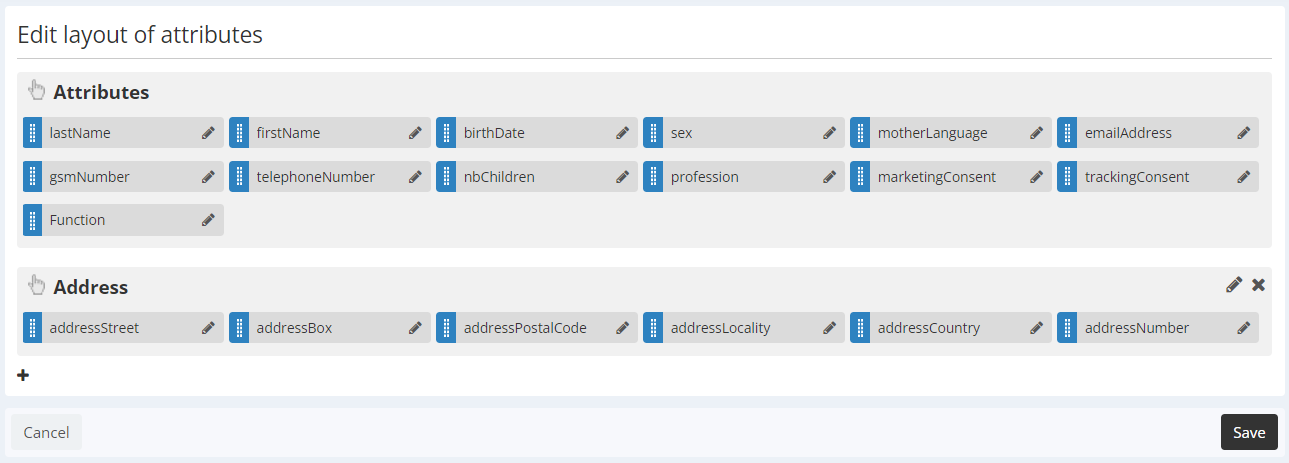
You can also modify the attributes' display names. For that, you just need to click on the pencil icon next to the attribute's name.
Once you have done all the desired modifications, don't forget to click on "Save" before leaving the application. You can now go to a profile file and see the new layout.
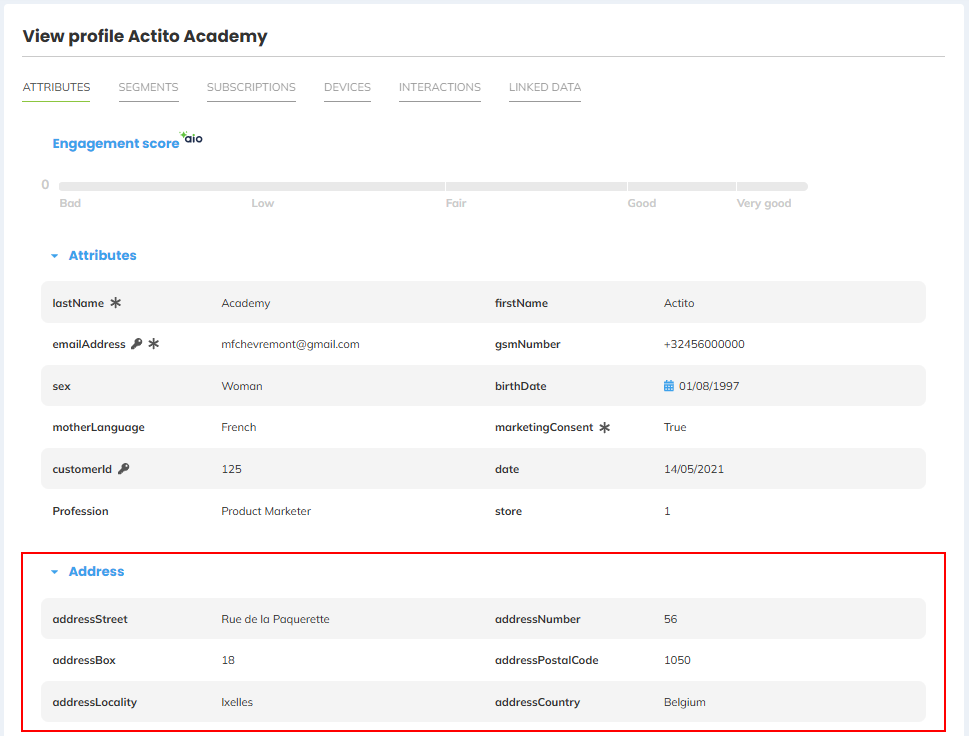
Segmentations
This tab gives you a general view of all the segments of which your profile is/used to be part of.
For more details about the definition of the segmentation, click on the 'eye' symbol in the 'Actions' column.
If the segmentation history is activated, you an click on the 'watch' icon to see the whole transition history of the profile (from a segment to another for exclusive segmentations, or when they entered or exited a simple segmentation).

If a profile moves multiple times from a segment to another (or exit and re-enter the segmentation) during the same day, only the last value is kept in the segmentation history.
A warning icon indicates that multiple transitions have taken place: this typically means that there is an issue with your segmentation rules, such as a gap or an overlap between your criteria.
An inactive profile can of course be reactivated, but a profile shouldn't move back and forth from a segment to another during the same day: this is a sign that tout segmentation rules should be double checked.

Subscriptions
This tab gives you a general view of all the subscriptions linked to your profile.

You will be notified if your profile has currently no subscription.
Checking the 'Show all subscriptions' box will display all the existing subscriptions of your table, with their status for the selected profile. You can also see the subscription history of the profile.
Devices
This tab contains information about the devices linked to this profile.
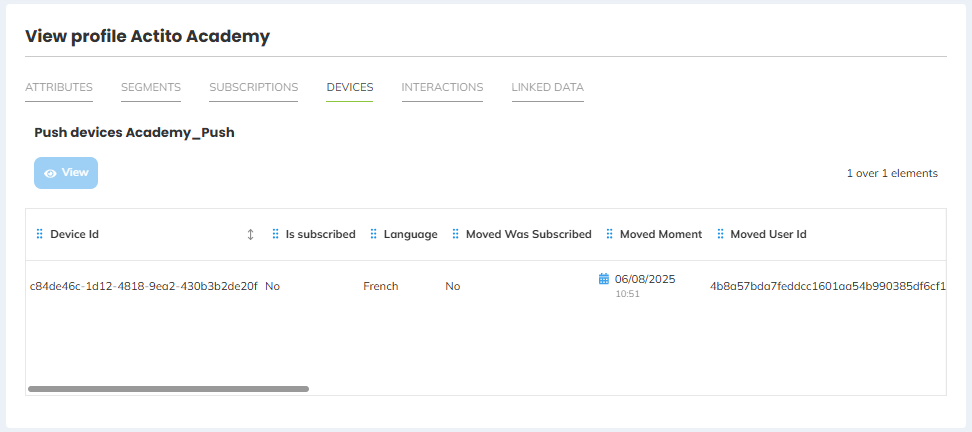
If you want to see all the information about a device, you can click on the desired device and then on "View".
Interactions
This tab shows all the types of interactions between you/your brand and the profile, both within Actito and/or in the custom tables.
You can filter interactions by types : click on one or more types to deselect them.
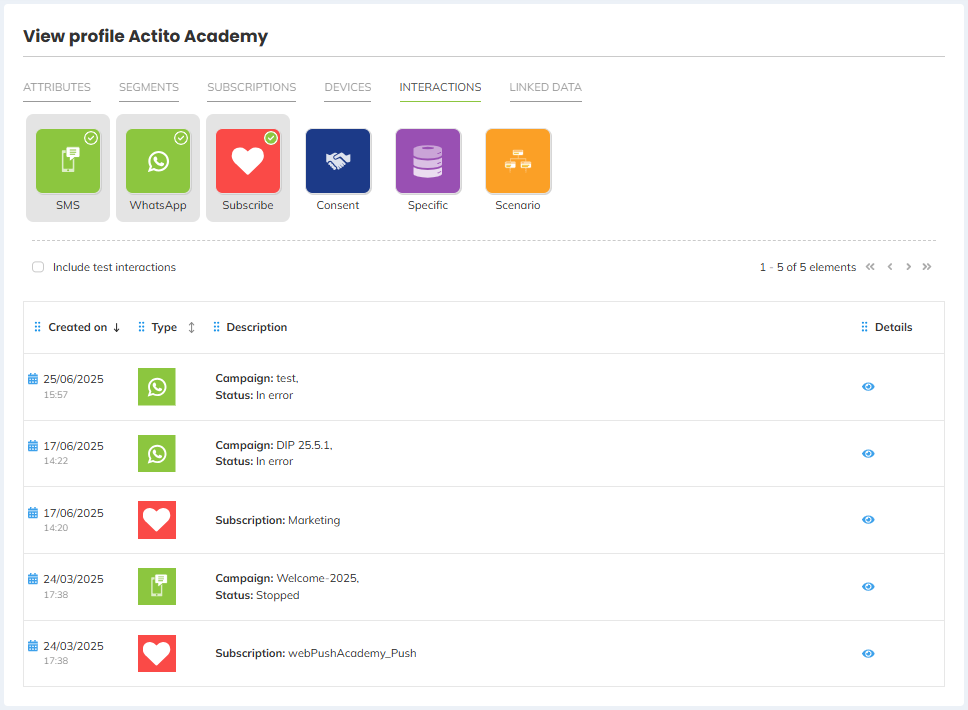
For more details about an interaction, click on the 'eye' symbol in the 'Details' column.
Email interactions are explained in this article.
Linked data
This tab contains information about additional elements related to this profiles and stored in a "linked data" table, such as children, pets, loyalty card, ...
